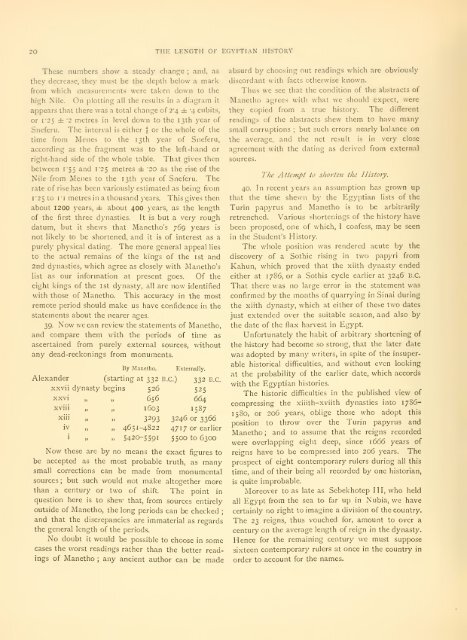Historical studies
Historical studies
Historical studies
Create successful ePaper yourself
Turn your PDF publications into a flip-book with our unique Google optimized e-Paper software.
20 Tin: LENGTH OF EGYPTIAN HISTORV<br />
These numbers show a steady chanf;e ; and, as<br />
they decrease, they must be the depth below a mark<br />
from which measurements were taken down to the<br />
high Nile. On plotting all the results in a diagram it<br />
appears that there was a total change of 24 ± 4 cubits,<br />
or r25 ± "2 metres in level down to the 13th year of<br />
Sncferu. The interval is cither j or the whole of the<br />
time from Mcnes to the 13th year of Sneferu,<br />
according as the fragment was to the left-hand or<br />
right-hand side of the whole table. That gives then<br />
between r55 and r25 metres ± 20 as the rise of the<br />
Nile from Menes to the 13th year of Sneferu. The<br />
rate of rise has been variously estimated as being from<br />
r25 to ri metres in a thousand years. This gives then<br />
about 1200 years, ± about 400 jears, as the length<br />
of the first three dynasties. It is but a very rough<br />
datum, but it shews that Manetho's 769 years is<br />
not likely to be shortened, and it is of interest as a<br />
purely physical dating. The more general appeal lies<br />
to the actual remains of the kings of the ist and<br />
2nd dynasties, which agree as closely with iManetho's<br />
list as our information at present goes. Of the<br />
eight kings of the ist dynasty, all are now identified<br />
with those of Manetho. This accuracy in the most<br />
remote period should make us have confidence in the<br />
statements about the nearer ages.<br />
39. Now we can review the statements of Manetho,<br />
and compare them with the periods of time as<br />
ascertained from purely external sources, without<br />
any dead-reckonings from monuments.<br />
By Manetho. Externally.<br />
Alexander (starting at 332 B.C.) 332 B.C.<br />
xxvii dynasty begins 526 525<br />
xxvi „ „ 656 664<br />
xviii „ „ 1603 1587<br />
xiii „ „ 3293 3246 or 3366<br />
iv „ „ 4651-4822 4717 or earlier<br />
i „ „ 5420-5591 5500 to 6300<br />
Now these are by no means the exact figures to<br />
be accepted as the most probable truth, as many<br />
small corrections can be made from monumental<br />
sources ; but such would not make altogether more<br />
than a century or two of shift. The point in<br />
question here is to shew that, from sources entirely<br />
outside of Manetho, the long periods can be checked ;<br />
and that the discrepancies are immaterial as regards<br />
the general length of the periods.<br />
No doubt it would be possible to choose in some<br />
cases the worst readings rather than the better readings<br />
of Manetho ; any ancient author can be made<br />
absurd by choosing out readings which are obviously<br />
discordant with facts otherwise known.<br />
Thus we see that the condition of the abstracts of<br />
Manetho agrees with what we should expect, were<br />
they copied from a true history. The different<br />
readings of the abstracts shew them to have many<br />
small corruptions ; but such errors nearly balance on<br />
the average, and the net result is in very close<br />
agreement with the dating as derived from external<br />
sources.<br />
The Attempt to shorten tlu History.<br />
40. In recent years an assumption has grown up<br />
that the time shewn by the Egyptian lists of the<br />
Turin papyrus and Manetho is to be arbitrarily<br />
retrenched. Various shortenings of the history have<br />
been proposed, one of which, I confess, may be seen<br />
in the Student's History.<br />
The whole position was rendered acute by the<br />
discovery of a Sothic rising in two papyri from<br />
Kahun, which proved that the xiith dynasty ended<br />
either at 1786, or a Sothis cycle earlier at 3246 B.C.<br />
That there was no large error in the statement was<br />
confirmed by the months of quarrying in Sinai during<br />
the xiith dynasty, which at either of these two dates<br />
just extended over the suitable season, and also by<br />
the date of the flax harvest in Egypt.<br />
Unfortunately the habit of arbitrary shortening of<br />
the history had become so strong, that the later date<br />
was adopted by many writers, in spite of the insuper-<br />
able historical difficulties, and without even looking<br />
at the probability of the earlier date, which accords<br />
with the Egyptian histories.<br />
The historic difficulties in the published view of<br />
compressing the xiiith-xviith dynasties into 1786-<br />
1580, or 206 years, oblige those who adopt this<br />
position to throw over the Turin papyrus and<br />
Manetho ; and to assume that the reigns recorded<br />
were overlapping eight deep, since 1666 years of<br />
reigns have to be compressed into 206 years. The<br />
prospect of eight contemporary rulers during all this<br />
time, and of their being all recorded by one historian,<br />
is quite improbable.<br />
Moreover to as late as Sebekhotep III, who held<br />
all Egypt from the sea to far up in Nubia, we have<br />
certainly no right to imagine a division of the country.<br />
The 23 reigns, thus vouched for, amount to over a<br />
century on the average length of reign in the dynasty.<br />
Hence for the remaining century we must suppose<br />
sixteen contemporary rulers at once in the country in<br />
order to account for the names.

















